Changes to Prop. 65 Warning Rules Proposed (Again)
By Lauren Mendelsohn
January 18, 2021 (Updated February 20, 2021)
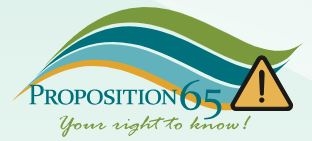
On January 8, the Office of Environmental Health Hazard Assessment (OEHHA), the agency responsible for overseeing California’s Proposition 65, announced that it was proposing to amend (again) the regulations pertaining to consumer product warnings. Specifically, the OEHHA is proposing to tighten up the rules on use of the “short-form” on-product warning so that consumers can be more meaningfully informed about the risk of exposure to potentially harmful chemicals.
Cannabis companies should take note of this, as they are frequently targeted for allegedly violating Proposition 65. (We’ve written about this law previously on our blog here, here and here.)
Below are documents and information related to OEHHA’s latest proposed rulemaking:
California’s Proposition 65, more formally known as the Safe Drinking Water and Toxic Enforcement Act of 1986 (codified at Cal. Health & Safety Code § 25249.5 et seq.), requires businesses to provide clear and reasonable warnings on or with any products that could expose consumers or employees to chemicals known by the state of California to cause reproductive toxicity or cancer. OEHHA maintains lists of these chemicals online.
As far as cannabis operators are concerned, a number of chemicals which may be present in cannabis products are included on the state’s Proposition 65 list for either cancer or reproductive harm or both, including cannabis smoke, Δ9-THC (THC), and even naturally-occurring terpenes such as isoprene and myrcene. Thus, most cannabis products should contain a warning about potential exposure. (Note: Businesses with less than 10 employees are exempt from Prop. 65’s warning requirements.)
In 2016, OEHHA adopted new warning regulations that went into effect in 2018 that modified the content and format of consumer product warnings. Major changes included: (1) requiring at least one chemical prompting the warning be identified; (2) requiring inclusion of the Prop 65 web address in the warning; (3) altering the language of the warning to say a product “can expose you to” a chemical rather than a product “contains” a chemical; (4) including of a new triangular yellow warning symbol in the warning; and (4) allowing short form warnings for on-product warnings. OEHHA’s intent was for the short-form warning to be used if there wasn’t enough room to include the full warning on a product’s label or packaging; however, this was not made a requirement by the 2016 regulations.
Given the limited amount of room on cannabis packaging (the products themselves aren’t that large, and there is a lot of other required information that has to fit on the label), the short-form warning has become quite popular with businesses in California in the past couple of years. However, it is precisely this short-form warning that the newly proposed amendments focus on.
According to the Initial Statement of Reasons, OEHHA has received many complaints since the 2016 regulations went into effect from consumers who do not feel that the short-form warning is adequate and want to know which chemicals they may be exposed to. OEHHA therefore determined it needs to make amendments to satisfy the intent of Prop. 65 — to provide clear and reasonable warnings to consumers about possible exposures to potentially harmful substances — and their intent in adopting the 2016 warning regulations. [Initial Statement of Reasons (2021), pp. 5-8.]
“Without these changes, use of the short-form warning will continue to be inconsistent with the intent of the Act and OEHHA’s intent in adopting the 2016 regulations — that warnings communicate meaningful information about chemical exposures to consumers, and that short-form warnings be used only on labels for small products that cannot accommodate the full-length warning content described in Section 25603(a).” [ISOR (2021), p. 4.]
The proposed amendments would require that at least one chemical from each list that is implicated be mentioned. The amendments would also limit use of the short-form warning to instances where: (1) the total surface area for Prop. 65 information on the product label is 5 square inches or less; (2) the package can’t fit the full-length warning; and (3) the warning is printed in font no smaller than the largest font size used for consumer information on the label and also no smaller than 6 point. Additionally, the short-form warning would no longer be allowed for internet and catalog purchases.
Below is a table depicting the evolution of consumer product warnings under Prop. 65:
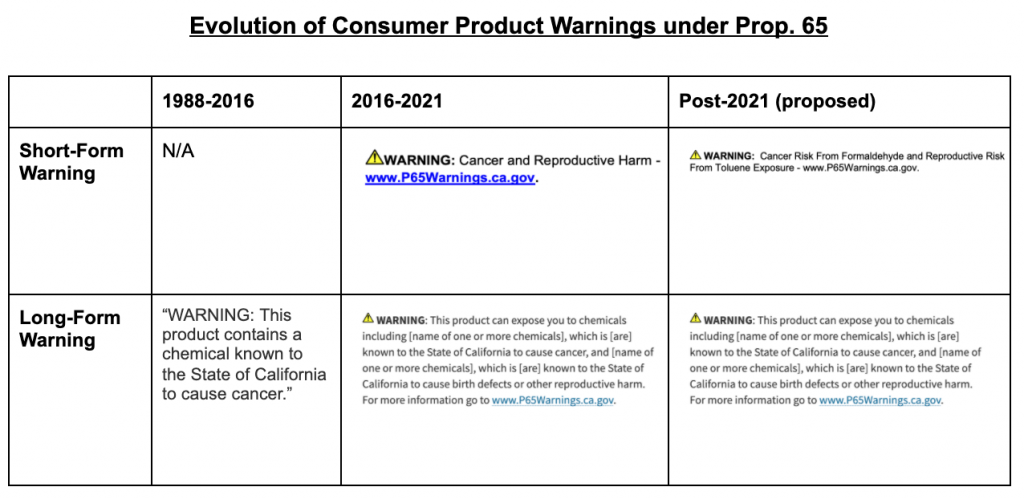
2021 © Law Offices of Omar Figueroa
To ease the burden of coming into compliance with the proposed regulations, there would be a one-year “grace period” to provide the updated warning. Furthermore, products made before that date would be deemed sufficient if they comply with the August 2016 amendments. Below are the proposed amendments, indicated via highlighting and strikethroughs.
Section 25601 describes the basic methods and content for a warning to be considered clear and reasonable:
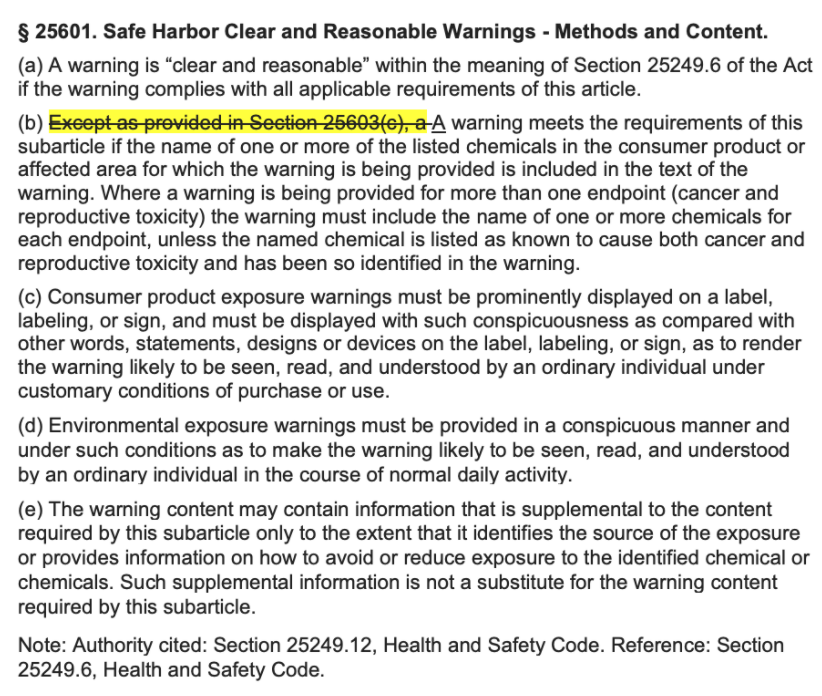
Section 25602, which deals with the method of transmission for consumer product warnings:
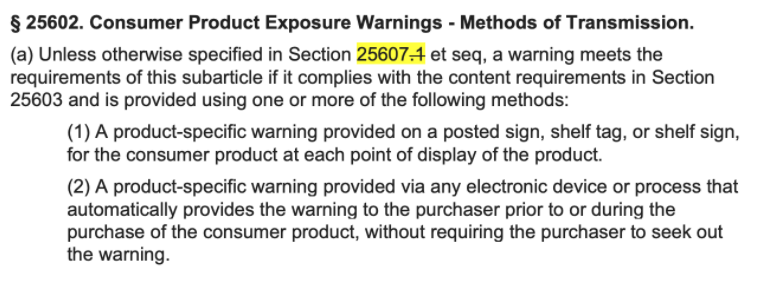
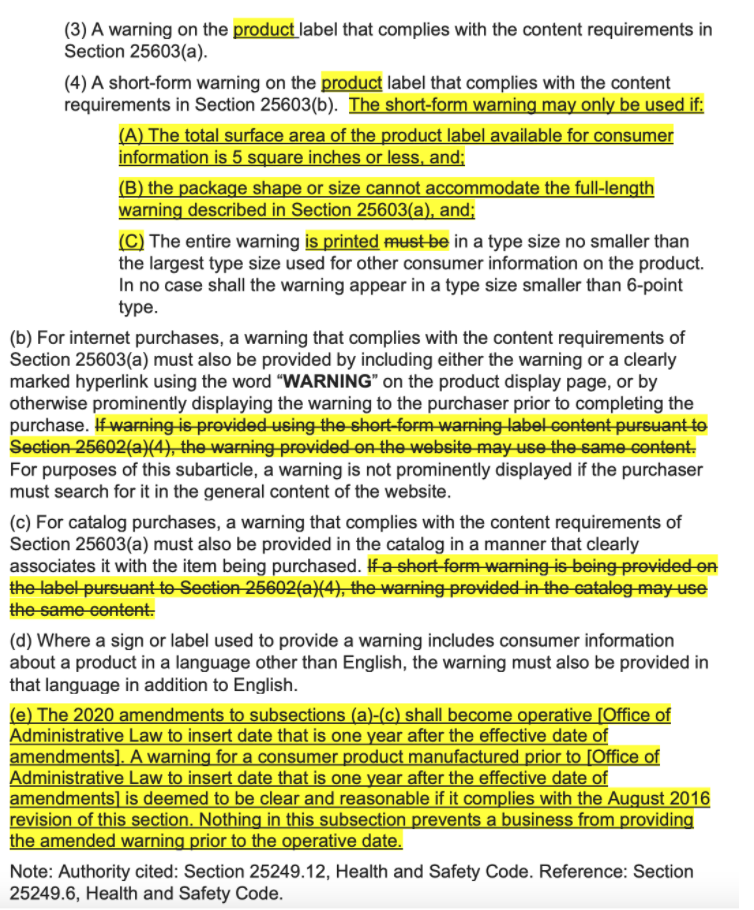
Section 25603, which deals with the content of consumer product exposure warnings:
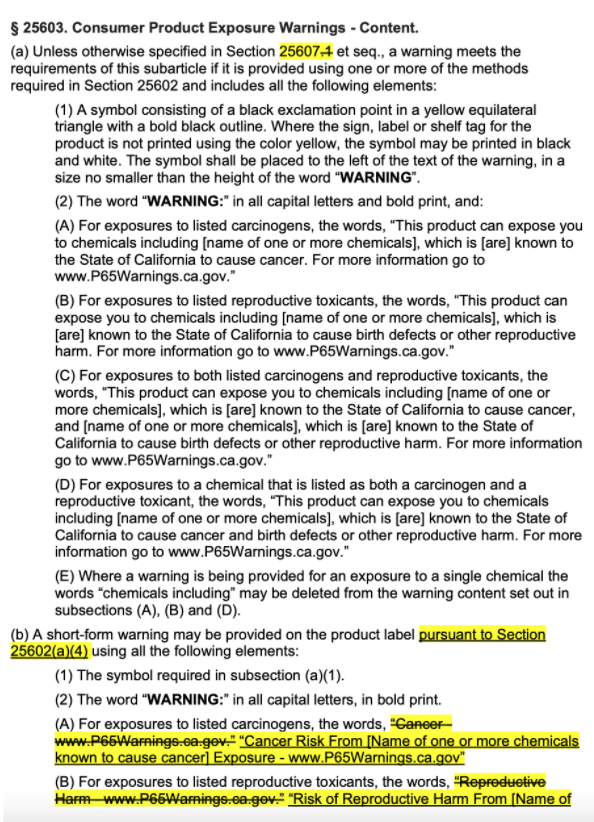
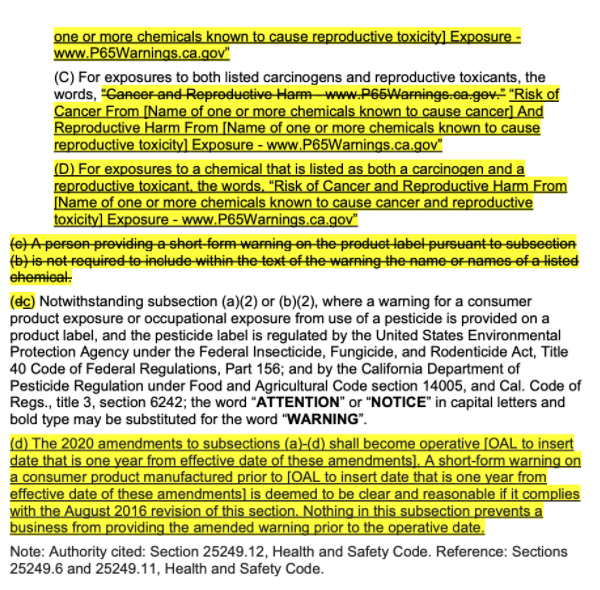
Changes that largely mirror the amendments in Section 25603 are also being proposed to Section 25607.2, which deals with warnings for food products. (However, note that cannabis goods are not considered “food” under California law; and neither THC nor CBD are approved by the FDA as a food product, additive, or dietary supplement.)
Below are examples of what a short-form warning would look like under the proposed amended regulations, all on 5 square inches or less of the label area:
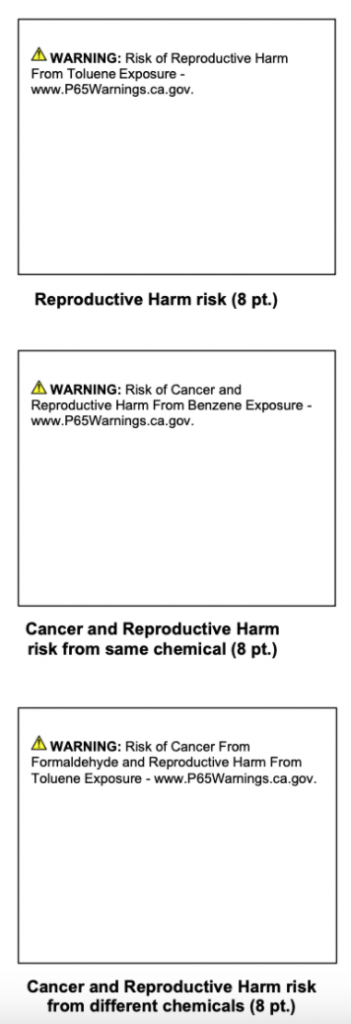
Written comments on the proposed amendments to the warning regulations must be sent to OEHHA by March 8, 2021 and can be submitted online here. Comments can also be submitted via regular mail, fax or in-person, though electronic submissions are preferred. Any non-electronic comments should be sent to the address listed in the Notice of Proposed Rulemaking.
OEHHA is not planning to hold a public hearing on these proposed amendments unless one is requested. Given the ongoing COVID-19 crisis, any such hearings would be virtual. To request a hearing, email Monet Vela at monet.vela@oehha.ca.gov by February 22. If a hearing is scheduled, notice will be provided to interested parties and published on the OEHHA website at least 10 days prior to the hearing.
***UPDATE 2/20/21: A public hearing was requested and therefore has been scheduled for March 11, 2021 at 10:00am PST. The public comment period has been extended until March 29, 2021. For more information visit this page.***
Please note that comments submitted to OEHHA are considered public records, and may be disclosed to third parties in accordance with the California Public Records Act and similar laws.
Stay tuned to our blog for more information about Proposition 65 and its impact on cannabis and hemp businesses, employees and consumers.
This information is provided as an educational public service and is not intended as legal advice. For specific questions regarding California’s Proposition 65, including how cannabis and hemp companies can comply with warning requirements, contact the Law Offices of Omar Figueroa at (707) 829-0215 or info@omarfigueroa.com to schedule a confidential consultation.
